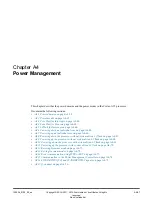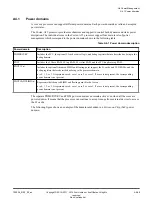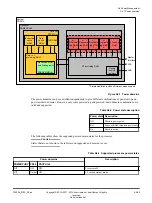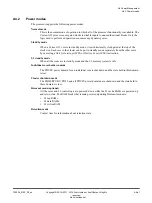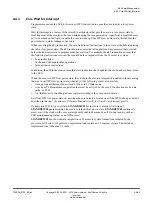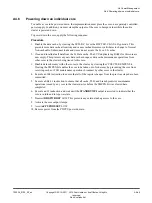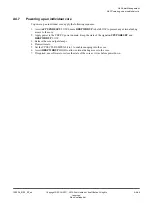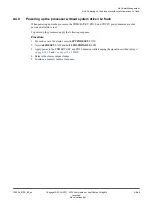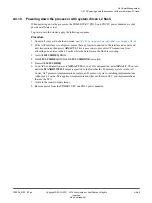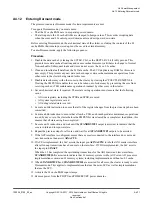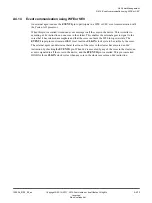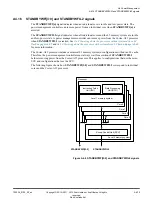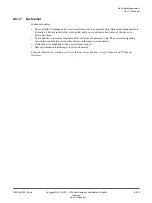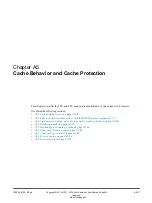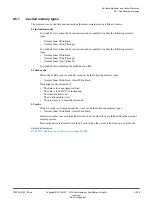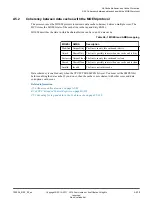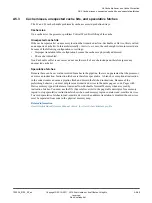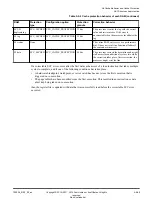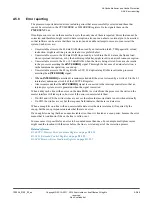
A4.12
Entering Dormant mode
The processor can enter Dormant mode if certain requirements are met.
To support Dormant mode, you must ensure:
• That the L2 cache RAMs are in a separate power domain.
• That all inputs to the L2 cache RAMs are clamped to benign values. This avoids corrupting data
when the cores and L2 control power domains enter and exit power down state.
Before entering Dormant mode, the architectural state of the cluster, excluding the contents of the L2
cache RAMs that remain powered up, must be saved to external memory.
To enter Dormant mode, apply the following sequence:
Procedure
1. Disable the data cache by clearing the SCTLR.C bit, or the HSCTLR.C bit if in Hyp mode. This
prevents more data cache allocations and causes cacheable memory attributes to change to Normal
Non-cacheable. Subsequent loads and stores do not access the L1 or L2 caches.
2. Clean and invalidate all data from the L1 Data cache. The SCU duplicate tag RAM for this core is
now empty. This prevents any new data cache snoops or data cache maintenance operations from
other cores in the cluster being issued to this core.
3. Disable data coherency with other cores in the cluster, by clearing the CPUECTLR.SMPEN bit.
Clearing the SMPEN bit enables the core to be taken out of coherency by preventing the core from
receiving cache or TLB maintenance operations broadcast by other cores in the cluster.
4. Save architectural state, if required. These state saving operations must ensure that the following
occur:
• All Arm registers, including the CPSR and SPSR, are saved.
• All system registers are saved.
• All debug related state is saved.
5. Execute an
ISB
instruction to ensure that all of the register changes from the previous steps have been
committed.
6. Execute a
DSB
instruction to ensure that all cache, TLB, and branch predictor maintenance operations
issued by any core in the cluster before the SMPEN bit was cleared have completed. In addition, this
ensures that all state saving has completed.
7. Execute a
WFI
instruction and wait until the
STANDBYWFI
output is asserted, to indicate that the
core is in idle and low-power state.
8. Repeat the previous steps for all cores, and wait for all
STANDBYWFI
outputs to be asserted.
9. If the ACP interface is configured, ensure that any master connected to the interface does not send
new transactions, then assert
AINACTS
.
10. If ACE is implemented, the SoC asserts the input pin
ACINACTM
to idle the AXI master interface
after all snoop transactions have been sent on the interface. If CHI is implemented, the SoC asserts
the input pin
SINACT
.
When the L2 has completed the outstanding transactions for the AXI master and slave interfaces,
STANDBYWFIL2
is asserted to indicate that L2 memory system is idle. All Cortex
‑
A35 processor
implementations contain an L2 memory system, including implementations without an L2 cache.
11. When
STANDBYWFI
and
STANDBYWFIL2
are asserted for all cores, the cluster is ready to enter
Dormant mode. This applies to implementations that use the mini-SCU as well as implementations
that use the SCU.
12. Activate the L2 cache RAM input clamps.
13. Remove power from the PDCPU and PDMERCURY power domains.
A4 Power Management
A4.12 Entering Dormant mode
100236_0100_00_en
Copyright © 2015–2017, 2019 Arm Limited or its affiliates. All rights
reserved.
A4-71
Non-Confidential
Summary of Contents for Cortex-A35
Page 4: ......
Page 18: ......
Page 26: ......
Page 27: ...Part A Functional Description ...
Page 28: ......
Page 145: ...Part B Register Descriptions ...
Page 146: ......
Page 573: ...Part C Debug ...
Page 574: ......
Page 845: ...Part D Appendices ...
Page 846: ......

